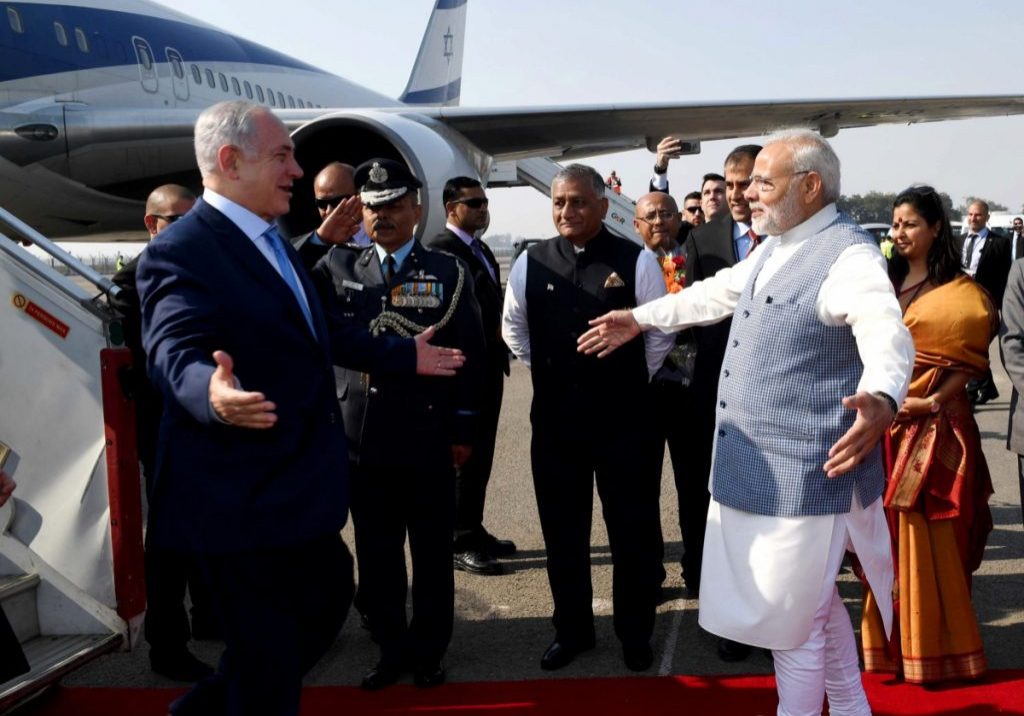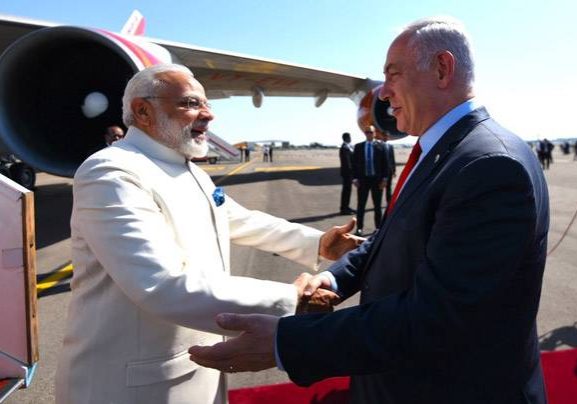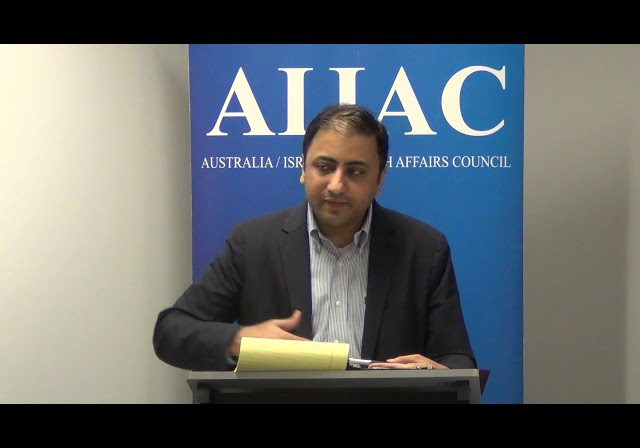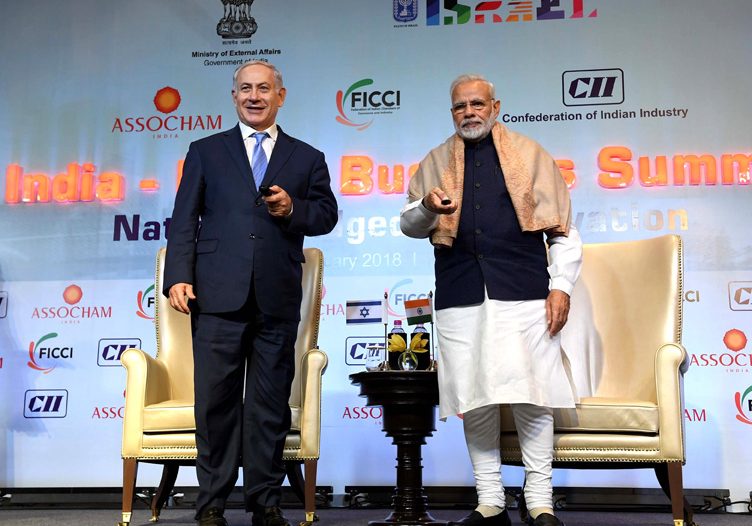Australia/Israel Review
The Match between India and Israel
Aug 3, 2017 | Jonathan Spyer

Jonathan Spyer
The recent two-day visit of Narendra Modi to Israel, the first ever by an Indian Prime Minister, has been depicted as heralding a new strategic partnership between New Delhi and Jerusalem. Indeed, simply by taking place at all, it represented an upgrade of the relationship.
Hitherto, the growing connections between India and Israel had taken place behind the scenes, according to India’s preference. New Delhi did not wish to ruffle feathers in the Arab and Muslim worlds, and among its own large Muslim population. Thus, the pillars of the relationship have been mainly economic. Overall trade has grown from around US$200 million in 1992, when diplomatic relations were established, to US$4.2 billion in 2016. During Modi’s visit, representatives of the two nations signed agreements on cooperation in the fields of agriculture, water and space. The first two of these areas, in which Israel possesses world-class expertise, are of direct and particular relevance to India. Meanwhile, back in April, Israel Aerospace Industries was awarded the largest single defence contract in the history of Israel’s defence industry: a US$1.6 billion deal with the Indian Army, for the provision of surface-to-air missiles and air and missile defence systems. An additional US$400 million in contracts went to Rafael Advanced Defence Systems for developments in the same areas.
Historically, diplomatic ties between the two countries have been noticeably weaker. India was traditionally among the most vociferously pro-Palestinian countries in international forums, though this is slowly starting to shift. India has in recent months abstained on a number of UN resolutions critical of Israel, when its support would once have been automatic. The field of cooperation on counter-terrorism is deeply relevant here: Indian officials dealing with these matters have spoken to me of their appreciation for the speedy and practical responses of their Israeli counterparts. However, India maintains close relations with Iran, due to New Delhi’s burgeoning energy needs, and is unlikely ever to support a renewed campaign of isolation.
Modi’s visit announces the arrival of something new: an openly proclaimed partnership that is diplomatic as well as economic. His decision to break with protocol and refrain from visiting the Palestinian Authority in Ramallah further reinforces the message.
Countries operate according to interest, not sentiment, so we must be wary of reading too much into the visit. But the international system is also full of relationships between states that transcend merely instrumental concerns, and are instead based on perceived deeper commonalities. The US relationship with Israel is an example of a relationship of this kind. The bond between the United States and other English-speaking countries, based on common Anglo-Saxon cultural, political and legal heritage, is another. Now, such a connection may well be emerging between Israel and India.
Commonalities that would make such a relationship possible are visible in the political and even cultural trajectories of both countries. Can comparisons and connections really be drawn between a massive, settled, and ancient sub-continent of 1.3 billion people in the heart of South Asia and a tiny, re-established Jewish state of 8.4 million on the western edge of the same continent? The answer is yes, but a deeper look at the political culture and history of both countries is required.
To understand these, we cannot look upon “Israel” and “India” as unified wholes. Rather, we must observe the specific political contexts that shaped Binyamin Netanyahu and Narendra Modi, and the political traditions to which they belong.
The modern republics of India and Israel were established within a few months of each other. The dominant national movements that piloted these newborn states – the Israel Workers Party (Mapai) in Israel and Congress in India – had a considerable amount in common. They were self-consciously secular, left-leaning parties, concerned in the fashion of the time with rapid development and constructing the future. Despite their resemblances, Congress and Mapai did not preside over a partnership between their respective countries, due to their sharply different stances on the key foreign policy issue of the day: the Cold War.
Neither Modi nor Netanyahu is associated with these movements. Rather, they are the scions of the opposition movements created during those days of foundation, and which have since taken the helm in both nations.
Many Israelis and foreign observers see Netanyahu as an Americanised figure, one step removed from the deeper political traditions in Israel. This is only half the story, however. Netanyahu’s family history, career and outlook are steeped in a particular Zionist tradition – namely the current known as Revisionist Zionism.
The Israeli Prime Minister’s father, Ben-Zion, was the personal secretary of Ze’ev Jabotinsky, the founder of that movement. Even Binyamin Netanyahu’s connection to the United States derives from his father’s lifelong association with this movement. The domination by Mapai of Israel’s institutions in the 1950s made it close to impossible for individuals associated with the rival Revisionist current to make academic careers in Israel, at least in the humanities. Thus, Ben-Zion Netanyahu decided to take up an academic position in the United States in 1956, bringing his family to America, where young Bibi received much of his education.
The heirs of Revisionist Zionism have dominated Israeli political life since 1977. The ongoing electoral successes of Likud derive from a coalition of former “outsiders” in Israeli society who have now become the “inside”: Jews of North African and Middle Eastern extraction, and secular nationalists and religious traditionalists of East European origin. These groups were excluded or relegated to secondary status in the version of Israel established by Mapai.
The essential outlook uniting them has remained constant – a hawkish attitude toward the surrounding Arab/Muslim powers and populations, support for the United States and the West, an embrace of free-market capitalism, and a close attachment to Jewish religious tradition.
Binyamin Netanyahu is the scion of this movement, and he today stands at the head of it. It may well be that Netanyahu is the last (secular) Israeli politician to possess such a clear and unmistakable link to one of Israel’s founding traditions. Today, secular Israeli parties have become largely loose, improvised coalitions of ambitious politicians, or shells built around a single figure (such as Yair Lapid’s Yesh Atid.) But it is this background that explains why this MIT graduate and former special forces officer spent his first term as Prime Minister goading the “old elites” and the “media” for their alleged detachment from the realities of the region.
The history of Israel’s main opposition movement has a fascinating parallel in India’s own such movement. Like the Zionist revisionists, the Hindu nationalists of the Rashtriya Swayamsevak Sangh emerged in the 1920s – as the opposition to the Indian National Congress. The RSS was characterised by its advocacy of a “Hindu Rashtra” (Hindu nation) in contrast to the overt secularism of Congress. It organised its youth along paramilitary lines and created a military department. Throughout the history of the modern republic of India, RSS and its heirs have stood for a profoundly different vision of the country from that of Congress and its two seminal figures, Mahatma Gandhi and Jawaharlal Nehru.
Narendra Modi joined the RSS as a boy in Gujarat, and from the age of 21 in 1971 worked as a full-time organiser for the movement. He quickly rose through its ranks, finally become the leader of the Bharatiya Janata Party (BJP), an offshoot of the Bharatiya Jana Sangh, which was formed in 1951 in cooperation with the RSS, and generally regarded as its political arm. Modi returned the BJP to power after a ten-year absence (its first stint in power lasted from 1998 to 2004). His personal popularity, and his ability to extend the BJP’s support beyond its traditional base among upper-class and upper-caste Hindus, played a significant role in the victory, along with perceptions of widespread corruption in Congress.
In power, Modi, like Netanyahu, has engaged in a somewhat adversarial relationship with the country’s media. He has sought to use social media to bypass the traditional press. Modi combines Hindu nationalism and the use of potent traditional symbols with a focus on technology and development. He has spoken of his desire to build a “technology driven society.” This potent combination of course also mirrors Netanyahu’s outlook.
Of course, it should be noted that since the India-Israel “honeymoon” is to such a degree actually a romance between two particular currently dominant political streams, it is to a great extent dependent on their continued dominance. In this respect, it is inherently more vulnerable than the other “special relationships” mentioned above.
In an uncertain global political climate, in which political Islam is a primary cause of instability, it is not difficult to account for the current success of political movements such as those that Netanyahu and Modi represent. It is interesting to note that in the United States and Western Europe, these times have brought figures from outside of recognisable political traditions to prominence – Trump, of course, in the United States, Geert Wilders in Holland, Emmanuel Macron in France, and so on.
By contrast, Netanyahu and Modi emerge from stable, if oppositional, political traditions of long standing in their respective countries. The chemistry between them was evident throughout Modi’s brief visit in July. But it is rooted in more than personal connection. It is, or more accurately may prove to be, a match made in history.
Jonathan Spyer, a fellow at the Middle East Forum, is Director of the Rubin Centre for Research in International Affairs and author of The Transforming Fire: The Rise of the Israel-Islamist Conflict (Continuum, 2011). Reprinted from The American Interest. © Jonathan Spyer, reprinted by permission, all rights reserved.
Tags: India






